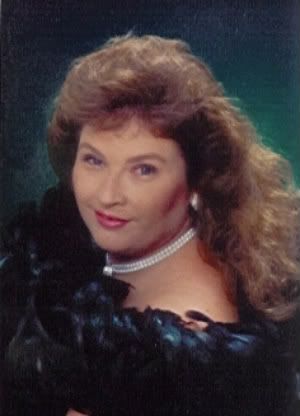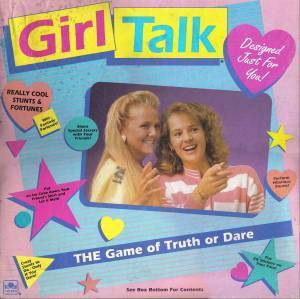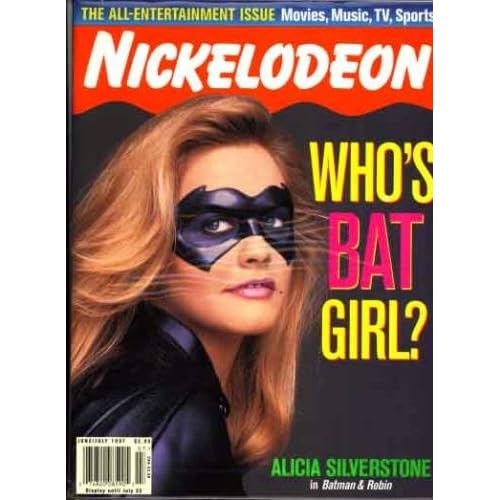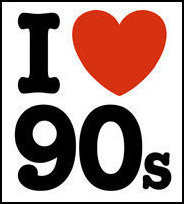On an aside, this is my 200th post! That's a whole lot of 90s. PS don't forget to enter all and any personal or family Glamour Shots in the Glamour Shots Challenge! Send your undoubtedly embarrassing photos to childrenofthe90s@gmail.com.
I know I'm about a month too late to engage in any sort of nationally conscious discussion during Banned Books week; my complete inattention to detail and timely pertinent bookstore displays is starting to show. It's an important issue at any time, though, and if it means we get to join in on mocking all those who seek to censor our allegedly inappropriate literary content, then all the better. If there's a bannedwagon out there, I'm jumping on it. Get it? Bannedwagon? Anyone?
*Cranes neck and shields eyes from monitor glare to gaze out at bewildered readers through their computer screens*
Painful puns aside, it's an issue many of us may not have been aware of as children but that continues to plague libraries and school systems everywhere. In any given society, there's bound to be a vocal contingency of uptight people engaging in the rectal transport of sticks. In a society that enourages free speech, however, the irony of their existence is no doubt lost on their closed minds. That is, the free speech stipulations that allow them to spout misguided uneducated drivel without consequence is the same ruling that upholds these authors' collective right to publish what they please. Quite a conundrum, huh?
Unsurprisingly, parents make up the majority of literary naysayers. It's natural for parents to be concerned about their innocent children's easily corruptible young minds, but the idea of each of us having our own parents is that families can make decisions for themselves and not society at large. Unfortunately, whoever yells the loudest often gains the widest audience, meaning these book banners garnered a lot of attention for their shouting and finger-pointing.
The most frequent reasons cited for protesting a book are sexuality, language, or "unsuitable material". In short, our intellectual freedom to grow and mature as eager young readers is most often suppressed by a bunch of prudes. Because why encourage a child to enjoy reading when you can teach them the value of complaining?
Here's a light sampling of the most frequently banned young adult books during the 90s. Many of the books were written decades earlier, but remained in the forefront of the censorship agenda:
The Giver

In this 1984-esque Utopian science fiction novel, Lois Lowry outlines a world of compliant individuals content to languish in their colorless world. The protagonist Jonas is stuck in a frightening sterile world where people are tightly controlled and exist without emotion. They even take pills to quell the sexual "stirrings" they feel beginning from puberty. You'd think our book banners would be all for that with all of their anti-sex rhetoric, but apparently what comes next is too inexcusable to give the book any merit in their eyes.
The Giver was banned largely for its themes of community-sanctioned suicide and euthanasia, the "release" characters receive if they fail to fit into the well-ordered society. Admittedly it's a pretty heavy issue for young children, but the book touts these behaviors as a negative consequence of an overly uniform society. In more common terms, they're saying it's bad. Don't do it. The book has a strong message of individuality and personal freedom, which we all know censors don't like one bit. It's no wonder they don't want us thinking for ourselves; they want us thinking for themselves.
Forever
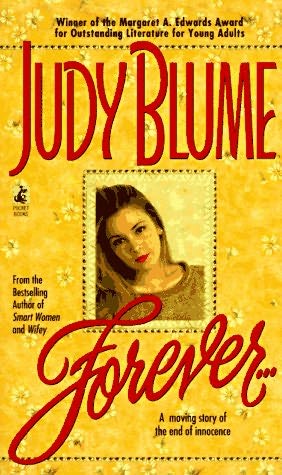
Oh, and pretty much every other book written by Blume over the span of the preceding few decades made the list. Some authors really know how to cause a stir amongst conservative morally straitjacketed PTA types. Forever was a shoo-in for raising a ruckus with its explicitly sexual content, detailing the experiences of a high school girl and her boyfriend's foray into physical intimacy. Let's put it this way: the book was released in 1975 and remains in one of the top spots on the banned books chart. I'll give you a hint why it remains so popular among young readers: it's about sex.
On an aside, some statisticians speculate that the dip in popularity of the name Ralph is in direct correlation to the fact that that's what the protagonist's boyfriend names his, er, private parts. Now that's a lasting impact.
Go Ask Alice

This story has a seriously awesome punchline. After years of speculation over the identity of the anonymous author of this drug-addled teenage memoir, it was revealed that it was actually penned by a Mormon youth minister. One of the censor-mongers' own! Ba-Dum-Ching!
Okay, so that didn't really kick the censorship habit. If anything, it just added fuel to the fire. As an anonymous diary, the book was provocative in its depictions of sexuality and extensive drug use. As a book written by a Mormon youth minister, it lost a little of that street credibility. Just a tad. Author Beatrice Sparks allegedly based the novel on the diary of one of her real psychiatry patients, but still. Regardless of the fact that the book is a cautionary tale against drug use, some parents obviously their kids will be drawn to try drugs after reading descriptions of the main character trying to bite her fingers off on a bad trip. Right.
Goosebumps

Not all banned books were contested on sexuality. Some were just plain unsavory. At least that's what parents claimed of the wildly popular Goosebumps series. The books had kids delighting in reading, but apparently at the cost of exposure to some cartoon-grade violence. The horror!
Alice Series

A book about teenagers with sex on the brain? Why, I've never heard of such a thing! On her own blog just a few weeks ago, Reynolds Naylor addressed the issue of parents protesting the content of her book:
It’s usually parents who want their children kept “pure,” as many parents tell me, “from harmful influences.” The mother of a ten year old girl was very angry with me for talking about how babies are conceived in Lovingly Alice. She wrote that since her daughter read that book, “the words penis and vagina will be forever ingrained on her mind.” Another mother tearfully accosted me because she found the word “condoms” in a novel for teenagers, and said, “My eighth grade son doesn’t know what condoms are and I don’t want him to know.” Whenever I hear comments like these, my heart really goes out to their children.
Well put, Phyll. Parents are entitled to raise their children however they see fit, and they certainly don't need to check this one out of the library for their kids if it's in contention with their moral values. It's general right to exist, however, is a whole different story. (That story is called Achingly Alice, available at bookstores near you!)
The Boy Who Lost His Face

The Boy Who Lost His Face was written by Louis Sachar, the author behind the Wayside School books. The protests against insinuations of witchcraft I may support, but I can understand them. My favorite challenge, however, was the inclusion of "obscene gestures". Yes, you read that right. The reader doesn't actually see any obscene gestures, he or she just reads a description of them.
Harry Potter

This one is probably sort of a given. Sorcery, witchcraft, magic: all that good stuff is more than enough ammunition to set off religious protest groups. Despite the fact that the novels fell into the fantasy genre, many censors fear that that faithful children will abandon their Biblical aspirations in favor of a career in the dark arts.
Many parents also feared the books were a bit too dark and scary for young children, which is a reasonably legitimate concern. I'd advise for those parents to not let their six year olds read it. On the other side of the banning spectrum, some critics contended Harry and his pals set a bad example for their kids. He gets into all sorts of mischief and doesn't always obey his elders. You know, he has fun and he's a kid. Quick, hide the book!
Scary Stories

They're too scary. We get it. Let's move on.
The Face on the Milk Carton

The "sexual content" charge, though minimal, I can kind of understand, but the "challenging of authority" allegation? I mean, the book is about a girl who's been kidnapped by her own grandparents. Whose authority exactly is in question? Is it just the general notion that adults can make mistakes, commit crimes, or otherwise act unwisely? It's a bit of a stretch, to say the least.
Everyone has the right to their own opinion, and my disparaging remarks about the tightly wound moral crusaders is just another blissful exercise in free speech. Let me freely say that most of these challenges are the most ridiculous, asinine ideas ever to spew from the mouths of overzealous overprotective over-meddling parents. You, of course, have the freedom to disagree with me. That's the beauty of it. Embrace it. Freely.










